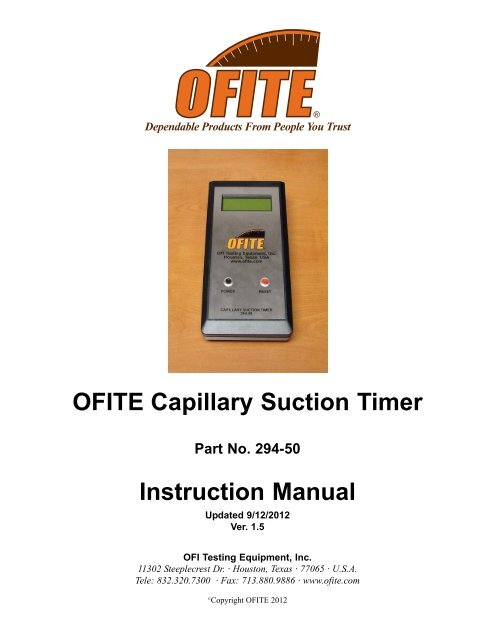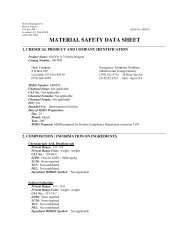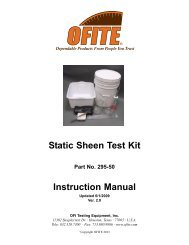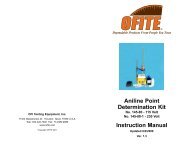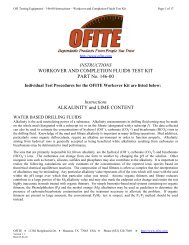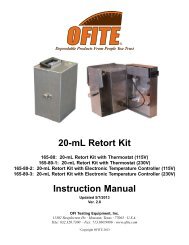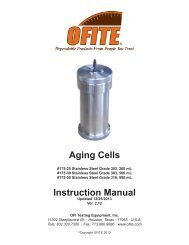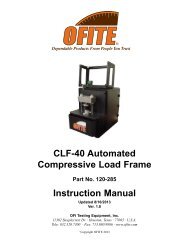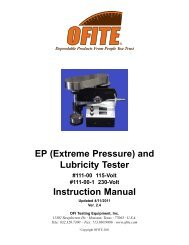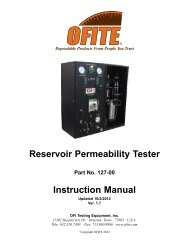Capillary Suction Timer - Instruction Manual - OFI Testing Equipment ...
Capillary Suction Timer - Instruction Manual - OFI Testing Equipment ...
Capillary Suction Timer - Instruction Manual - OFI Testing Equipment ...
Create successful ePaper yourself
Turn your PDF publications into a flip-book with our unique Google optimized e-Paper software.
<strong>OFI</strong>TE <strong>Capillary</strong> <strong>Suction</strong> <strong>Timer</strong><br />
Part No. 294-50<br />
<strong>Instruction</strong> <strong>Manual</strong><br />
Updated 9/12/2012<br />
Ver. 1.5<br />
<strong>OFI</strong> <strong>Testing</strong> <strong>Equipment</strong>, Inc.<br />
11302 Steeplecrest Dr. · Houston, Texas · 77065 · U.S.A.<br />
Tele: 832.320.7300 · Fax: 713.880.9886 · www.ofite.com<br />
©<br />
Copyright <strong>OFI</strong>TE 2012
Table of<br />
Contents<br />
Intro.......................................................................................................2<br />
Description...........................................................................................2<br />
Components.........................................................................................3<br />
Operation..............................................................................................4<br />
Notes.....................................................................................................5<br />
Maintenance.........................................................................................7<br />
<strong>OFI</strong>TE, 11302 Steeplecrest Dr., Houston, TX 77065 USA / Tel: 832-320-7300 / Fax: 713-880-9886 / www.ofite.com 1
Intro<br />
Description<br />
The <strong>Capillary</strong> <strong>Suction</strong> <strong>Timer</strong> (CST) principle was developed at the Water<br />
Pollution Research Laboratory in Stevenage, England, for studying the filterability<br />
of sewage sludge and for evaluating the effects of pretreatment<br />
chemicals and process conditions of sewage treatment. It has been widely<br />
used to study the colloidal properties of clay suspensions. The petroleum<br />
industry uses the CST to characterize shales and to optimize the electrolyte<br />
concentration in drilling fluids for minimizing its effect on shale formations.<br />
CST studies of filtration characteristics of aqueous systems utilize the capillary<br />
suction pressure of a porous paper to affect filtration. When a suspension<br />
is filtered under the influence of this suction pressure, the rate at<br />
which filtrate spreads away from the suspension is controlled predominately<br />
by the filterability of the suspension. The CST automatically measures<br />
the time for the filtrate to advance between radially separated electrodes<br />
when a fixed area of special filter paper is exposed to the suspension.<br />
The CST consists of two separate components - the acrylic filtration unit<br />
with the electrodes and a timer. The method is rapid and easy to use. A<br />
sample of the aqueous system to be tested is placed in the sample cylinder<br />
and the suction pressure of the filter paper beneath the sample draws out<br />
the filtrate. The filtrate progresses radially in an essentially elliptical pattern<br />
with the timer starting when the liquid reaches the first pair of electrodes.<br />
When the liquid reaches the third electrode, the timing ceases, and an<br />
audible signal is sounded. The CST reading is indicated on an LCD counter<br />
indicating to tenths of a second.<br />
<strong>OFI</strong>TE, 11302 Steeplecrest Dr., Houston, TX 77065 USA / Tel: 832-320-7300 / Fax: 713-880-9886 / www.ofite.com 2
#147-02 Battery, 9-Volt, Alkaline<br />
Components<br />
#294-01 Standard CST Paper; Whatman #17; Chromatography<br />
Grade; Package of 100<br />
#294-50-002 Sample Holder<br />
#294-50-004 Nylon Spacer<br />
#294-50-010 Upper Block<br />
#294-50-011 Lower Block<br />
#294-50-012 Electrode<br />
#294-50-013 Support Rod<br />
#294-50-015 Power Supply, 12-Volt<br />
#294-50-017 Adapter Set for Power Supply, 4-Plug Wall Clip (US, UK,<br />
European, and Australian)<br />
Optional:<br />
#294-05 Special CST Paper; Recommended for very viscous or slow filtering<br />
systems; Package of 300<br />
Upper Block<br />
(#294-50-010)<br />
Sample Holder<br />
(#294-50-002)<br />
Lower Block<br />
(#294-50-011)<br />
<strong>OFI</strong>TE, 11302 Steeplecrest Dr., Houston, TX 77065 USA / Tel: 832-320-7300 / Fax: 713-880-9886 / www.ofite.com 3
Operation<br />
1. Before each test, make sure the upper and lower blocks are clean and dry.<br />
2. Plug the upper block into the socket on the rear panel of the control box.<br />
3. Place a sheet of filter paper on the lower block. Place the upper block<br />
onto the lower block on top of the filter paper with the stainless steel<br />
probes facing down.<br />
4. The sample holder has two openings. One side has a 1 cm diameter<br />
opening for “fast” filtering. The other side has a 1.8 cm diameter opening<br />
for “slow” filtering. Insert the holder into the upper block and rotate it<br />
slightly while applying light downward pressure. This will ensure an<br />
even contact with the filter paper.<br />
5. Turn on the control box. The initial display will read:<br />
<strong>OFI</strong>TE Inc.<br />
<strong>Capillary</strong> <strong>Suction</strong> <strong>Timer</strong><br />
Firmware Ver: 1.xx<br />
When this display times out, it should read “<strong>Timer</strong> Ready 0.0 s”. If it<br />
does not, press the reset button to reset the controls.<br />
Note<br />
Note<br />
The CST will automatically power off after a period of inactivity. If this<br />
occurs while test results are displayed on the screen, the next time the<br />
unit is powered on, the previous results will be displayed again.<br />
The CST performs a continuity check on initial power-up and when the<br />
RESET button is pressed. If there is an electrical connection between<br />
the probes (e.g. if used test paper was left on the stand), the screen will<br />
display a continuity error. Make sure the upper and lower blocks and<br />
the paper are clean and dry, then try again.<br />
6. Using a syringe or pipette, pour 5 mL of sample fluid into the sample<br />
holder. Liquids from the sample will be absorbed by the filter paper in a<br />
circular pattern of increasing diameter. When the liquid reaches the first<br />
pair of contacts, the unit will beep and the timer will start. When the liquid<br />
reaches the third contact, the timer will stop and the unit will beep<br />
again. Record the timer reading. This is the “capillary suction time” in<br />
seconds and tenths of seconds.<br />
7. Carefully remove the upper block from the lower block and remove the<br />
sample holder. Remove and discard the filter paper. Thoroughly clean<br />
and dry the upper and lower blocks and the sample holder. Any moisture<br />
remaining on these components may affect future test results.<br />
8. Repeat this process at least 3 times per sample and average the results.<br />
9. When testing is complete, turn off the control box.<br />
<strong>OFI</strong>TE, 11302 Steeplecrest Dr., Houston, TX 77065 USA / Tel: 832-320-7300 / Fax: 713-880-9886 / www.ofite.com 4
Notes<br />
Several factors have a significant effect on the CST including the filter<br />
paper, temperature and suspended solids concentration.<br />
1. A double thickness of filter paper may be used to slow down the rate of<br />
travel of the liquid. This is sometimes useful with a very fast aqueous<br />
system.<br />
2. A special filter paper (#294-05) is available for very slow filtering systems.<br />
3. Whatman #17 chromatography grade filter paper is machine made and<br />
as a result has a grain in the paper. This grain produces a slightly elliptical<br />
wetted area instead of a circular wetted area. To assure that the<br />
CST is always measured along the major axis of the ellipse it is important<br />
to perform every test with the filter grain running parallel to the<br />
longer side of the lower block.<br />
4. Temperature has a significant effect on CST results. The CST decreases<br />
as the temperature of the fluid being tested increases. To minimize<br />
the effect of temperature on the fluid being tested, the samples should<br />
be at ambient temperature prior to performing the tests. The temperature<br />
of the fluid should also be recorded so corrections can be made if<br />
there are temperature variations among the samples.<br />
5. Suspended solids concentration has a significant effect on the test<br />
results. When using the CST procedure to evaluate drilling fluid additives,<br />
sludge conditioners, or assist in the operation of a dewatering<br />
process, this effect can be avoided by adhering to proper sample<br />
preparation procedures, particularly in ensuring homogeneity in each of<br />
the samples to be tested. Comparison of CST data between different<br />
original samples (especially if taken on different days) cannot be made<br />
with confidence unless suspended solids concentrations are comparable.<br />
A rough correction for different solids contents can be made by<br />
dividing the CST value by the solids concentration.<br />
6. It is recommended to take several readings (4 or 5) for each test.<br />
Discard any erroneous readings and then average the ones remaining.<br />
7. It is important to maintain solid contact between the electrodes and the<br />
test paper. Weights can be placed on the upper block to hold it down.<br />
8. Always place the device on a level surface and keep it stationary during<br />
testing. Avoid twisting the cable.<br />
9. To produce repeatable results, use a consistent delivery device for<br />
every test. It is recommended to use a pipette on a stand at a constant<br />
height and a pipetter.<br />
<strong>OFI</strong>TE, 11302 Steeplecrest Dr., Houston, TX 77065 USA / Tel: 832-320-7300 / Fax: 713-880-9886 / www.ofite.com 5
10. Make sure the device always has adequate power while testing. If<br />
available, AC power is preferable.<br />
11. For more information, refer to the following papers:<br />
“A Rectangular <strong>Capillary</strong> <strong>Suction</strong> Apparatus”; D.J. Lee and Y. H. Hsu;<br />
Ind. Eng. Chem. Res.; 1994.<br />
“Assessment of <strong>Capillary</strong> <strong>Suction</strong> Time (CST) Test Methodologies”; O.<br />
Sawalha and M. Scholz; Environmental Technology; Vol. 28; 2007.<br />
“Development of a Revised <strong>Capillary</strong> <strong>Suction</strong> Time (CST) Test”; Miklas<br />
Scholz and Julian Tapp; Water Conditioning and Purification; 2006.<br />
Polymer Deflocculants: Chemistry and Application; R.D. Wilcox and<br />
M.A.Jarrett, NL Baroid; IADC/SPE 17201; 1988.<br />
<strong>OFI</strong>TE, 11302 Steeplecrest Dr., Houston, TX 77065 USA / Tel: 832-320-7300 / Fax: 713-880-9886 / www.ofite.com 6
Maintenance<br />
1. Always keep the upper and lower blocks clean and dry. Occasionally<br />
clean the probes by drawing the block carefully with a slight downward<br />
pressure over 400 grit carborundum paper laid on a flat surface.<br />
2. This instrument uses a commonly available 9-volt battery (#142-02),<br />
which should provide many hours of operation before replacement is<br />
necessary. For maximum operational life, an alkaline type battery is recommended.<br />
A low-battery warning will display when it is time to replace the battery.<br />
To replace the battery:<br />
a. Turn the instrument OFF.<br />
b. Remove the two screws and lift the battery cover off. Remove<br />
the old battery and replace it with a fresh one. Place the battery<br />
cover back on the case and tighten the two screws.<br />
c. Turn the instrument on to verify operation.<br />
<strong>OFI</strong>TE, 11302 Steeplecrest Dr., Houston, TX 77065 USA / Tel: 832-320-7300 / Fax: 713-880-9886 / www.ofite.com 7


